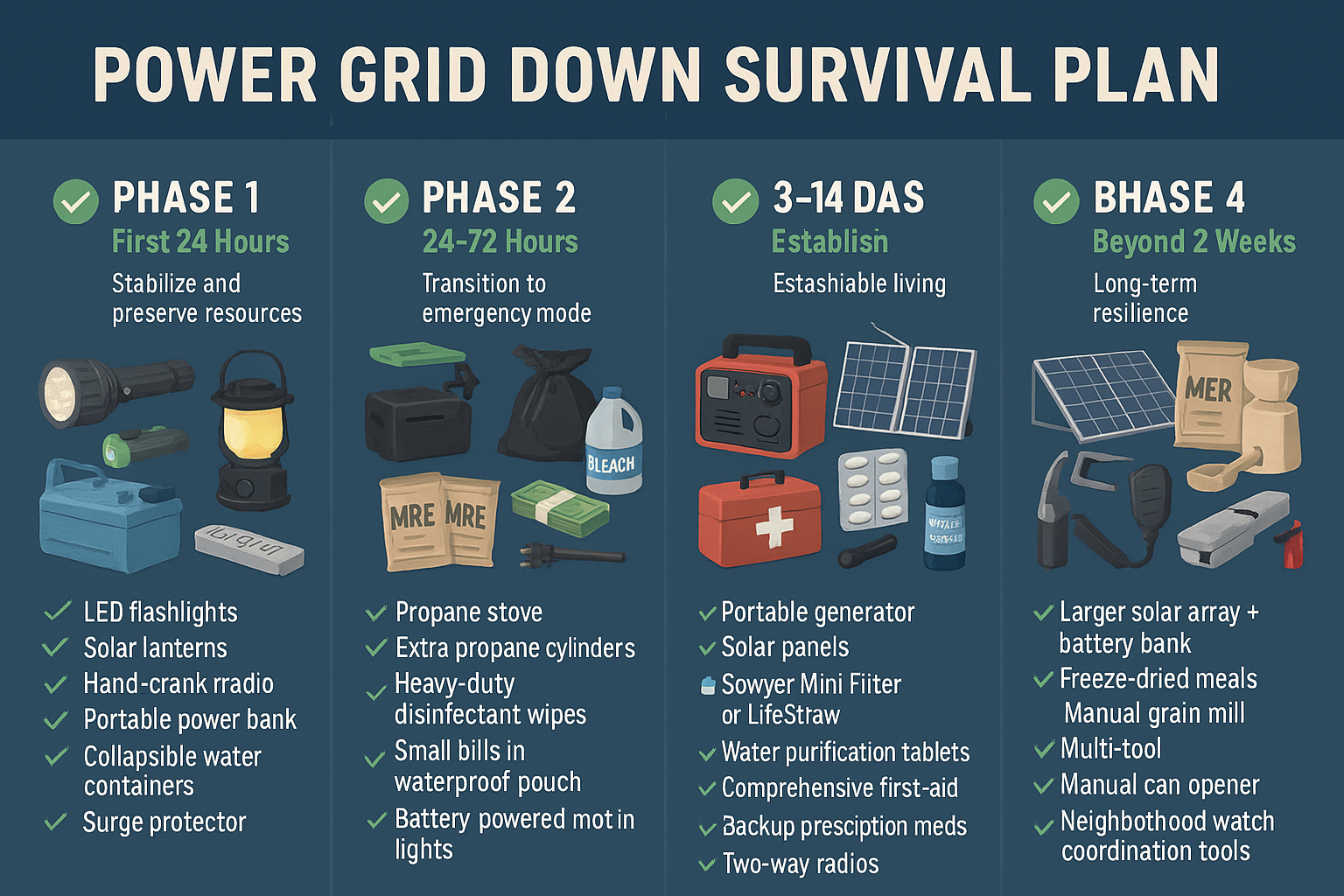Summary:
You will find a related article on my website: When the Electricity Goes Off: And the Inter-Connectivity of Utility Systems
Article:
Here’s a structured approach:
1. Immediate Actions When the Grid Goes Down: Taking immediate actions is not just crucial; it’s empowering. It puts you in control of your safety and comfort during a power outage.
- Stay Calm & Assess: This is the first and most crucial step. Confirm it’s a widespread outage by checking with neighbors or local news via a battery radio or phone. Keeping a level head is key to effective survival.
- Unplug Electronics: Prevent damage from surges when power returns.
- Preserve Battery Power: This is a resource you can’t afford to waste. Put devices in low-power mode and avoid unnecessary use. Every bit of battery power saved could be crucial in the long run.
- Secure Water Supply: Water is a basic necessity, and during a power outage, municipal pumps may fail. Fill bathtubs and containers as a precaution. Also, check if your city’s water source is a down-draft system, where water may be available for a limited period.
- Check Refrigeration: Keep the fridge/freezer closed; food lasts ~4 hours in the fridge and 48 hours in the freezer if unopened.
2. Short-Term Survival (First 72 Hours)
- Lighting: Use LED flashlights or solar lanterns (avoid candles for fire risk).
- Communication: Use a battery-powered or hand-crank radio for updates, and opt for text messaging instead of calls.
- Water: Minimum 1 gallon per person per day; use purification tablets or filters if needed.
- Food: Non-perishable items (canned goods, dry grains, protein bars).
- Cash: ATMs and card systems may fail—keep small bills handy.
3. Long-Term Preparedness (Weeks or More)
- Power Alternatives:
- Solar panels + battery storage.
- Portable generators (with safe fuel storage).
- Cooking: Propane or charcoal grills (outdoors only).
- Sanitation: Stock up on trash bags, bleach, and hygiene supplies.
- Medical: First-aid kit, essential prescriptions, backup glasses.
- Security: Locks, situational awareness—crime can rise during outages.
4. Community & Information: Building a strong community network is not just key; it’s comforting. It’s about surviving and thriving together during a power outage.
- Neighborhood Network: Share resources, check on vulnerable people.
- Local Alerts: Use ham radio or community bulletin boards as a backup in case the internet fails.
5. Skills to Learn: Acquiring new skills is not just preparation; it’s about feeling capable and ready to deal with a power outage.
- Water purification, basic first aid, alternative cooking methods, and how to safely operate generators.
Here’s a tiered survival plan for an extended power grid outage, broken down into actionable phases:
✅ Phase 1: First 24 Hours
Goal: Stabilize and preserve resources.
- Assess Situation: Confirm outage scope via battery radio or phone.
- Unplug Electronics: Prevent surge damage when power returns.
- Secure Water: Fill bathtubs and containers, aiming for 1 gallon per person/day.
- Preserve Food: Keep fridge/freezer closed; eat perishables first.
- Lighting: Use LED flashlights or solar lanterns (avoid candles).
- Communication: Use text instead of calls to conserve battery.
✅ Phase 2: 24–72 Hours
Goal: Transition to emergency mode.
- Water & Food: Begin rationing; use non-perishables (canned goods, dry grains).
- Cooking: Use propane or charcoal grills outdoors only.
- Sanitation: Stock trash bags, bleach, wipes for hygiene.
- Cash: ATMs may fail—use small bills for essentials.
- Security: Lock doors/windows; stay alert for crime spikes.
✅ Phase 3: 3–14 Days
Goal: Establish sustainable living.
- Power Alternatives: Solar chargers, portable generators (store fuel safely).
- Water Purification: Filters, tablets, or boiling.
- Medical: First-aid kit, prescriptions, backup glasses.
- Community: Share resources; check on elderly or vulnerable neighbors.
- Information: Ham radio or community bulletin boards for updates.
✅ Phase 4: Beyond 2 Weeks
Goal: Long-term resilience.
- Energy: Invest in solar panels + battery storage.
- Food Supply: Stockpile dry goods and learn preservation techniques (canning, dehydrating).
- Skills: First aid, water purification, and alternative cooking.
- Security: Consider joining a neighborhood watch or mutual aid group.
Here’s the expanded tiered survival plan with gear recommendations for each phase:
✅ Phase 1: First 24 Hours
Goal: Stabilize and preserve resources.
- Lighting:
- LED flashlights (e.g., Fenix PD35 or Streamlight ProTac)
- Solar lanterns (Goal Zero Crush Light)
- Communication:
- Hand-crank or battery-powered radio (Midland ER310)
- Portable power bank (Anker PowerCore 20,000mAh)
- Water:
- Collapsible water containers (Reliance Aqua-Tainer)
- Food:
- Ready-to-eat meals (MREs) or protein bars
- Other:
- Surge protectors for when power returns
✅ Phase 2: 24–72 Hours
Goal: Transition to emergency mode.
- Cooking:
- Propane stove (Coleman Portable Propane Stove)
- Extra propane cylinders
- Sanitation:
- Heavy-duty trash bags
- Bleach or disinfectant wipes
- Cash:
- Small bills in a waterproof pouch
- Security:
- Battery-powered motion lights
- Basic door reinforcement kit
✅ Phase 3: 3–14 Days
Goal: Establish sustainable living.
- Power Alternatives:
- Portable generator (Honda EU2200i or Jackery Explorer 1000 solar generator)
- Solar panels (Jackery SolarSaga or Goal Zero Boulder)
- Water Purification:
- Sawyer Mini Filter or LifeStraw
- Water purification tablets
- Medical:
- Comprehensive first-aid kit
- Backup prescription meds
- Community:
- Two-way radios (Baofeng UV-5R)
- Information:
- Ham radio setup
✅ Phase 4: Beyond 2 Weeks
Goal: Long-term resilience.
- Energy:
- Larger solar array + battery bank (Bluetti AC200P or EcoFlow Delta Pro)
- Food Supply:
- Freeze-dried meals (Mountain House or Augason Farms)
- Manual grain mill for flour
- Skills & Tools:
- Multi-tool (Leatherman Wave)
- Manual can opener
- Security:
- Neighborhood watch coordination tools
- Whistle and pepper spray for personal defense
Optional Regional Add-Ons (small badge)
- N95 masks (wildfire smoke), gas shutoff wrench, extra vehicle fuel, cooling towels/ice packs for heat waves, earthquake kit.
